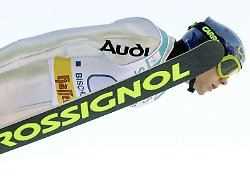Sunday, December 26th, 2021
Triumphs, crashes and curiosities
Legendary from 69 Four Hills Tournament
The Four Hills Tournament is one of the most fascinating and at the same time one of the most traditional events of the winter sports circus. The tour starts in its 70th edition with just a few stretches. It is quite possible that the best ski jumpers in the world will produce historical moments this season as well.
The myth of the Four Hills Tournament. History has often been written at the traditional ski jumping event that starts every year after Christmas. The 70th edition is now on the program in Oberstdorf, Garmisch-Partenkirchen, Innsbruck and Bischofshofen from December 29th. A look back:
Historic triumph
On January 6, 2002, Sven Hannawald prematurely crowned his career. The now 47-year-old was the first athlete to win all four competitions and thus entered himself in the history book. Millions of people watched RTL and numerous fans waited for their heroes at the ice-cold systems from the break of dawn. Hannawald was not alone with the quadruple victory: In 2017/18 the Pole Kamil Stoch, who was promptly embraced by Hannawald on the run, repeated the feat. One year after Stoch, the Japanese Ryoyu Kobayashi also made it.
Hannawald’s memories of the last jump in Bischofshofen are mixed: “I didn’t give a shit. Whether I win or not, whether I jump 50, 100 or 150 meters, it didn’t matter to me. I just wanted it to be over “said Hannawald” Sport Bild “. This winter marks the 20th anniversary of the quadruple victory. Since then, no other German jumper has captured the overall victory at the traditional event.
At the 70th edition, however, the chances are once again good: World Champion Karl Geiger starts as the overall World Cup leader in the tour, which he has already completed once in second place. Germany’s best ski jumper Karl Geiger believes in an end to the German lull at the Four Hills Tournament. “In the past few years, one of the German jumpers has always been involved, so the chances are very good. That’s why I think that we will crack the tour one day“, said the 28-year-old Oberstdorfer in an interview with the” Augsburger Allgemeine “.
The Chancellor congratulated with lightning speed
Sven Hannawald was recently amazed in the “Sport Bild” at how fast the Chancellor’s office was: “Chancellor Gerhard Schröder was the fastest.” Hannawald described how he made his last jump in Bischofshofen at 3:56 p.m. and just a minute later the fax from the SPD politician was received by the broadcasting TV station RTL. “A second after landing someone must have pressed the button,” said Hannawald.
Tied on points after eight jumps
The 2005/06 edition went down in the history books because the Finn Janne Ahonen and the Czech Jakub Janda had to share the overall victory after eight jumps. That was never before or after on the tour. Tour record winner Ahonen and his rival Janda got 1,081.5 points each. “There are two overall winners and two 33,000 euro cars as a prize,” said the tour spokesman at the time. The organizers could certainly do without a shared victory this year, because for the first time there is 100,000 Swiss francs (around 96,000 euros) as prize money.
The tour (almost) always increases
Due to a foehn storm on the infamous Innsbruck Bergisel, a jumping tour had to be canceled for the first time in January 2008. It was made up shortly afterwards in Bischofshofen, where two competitions were held that year. Again and again there was jumping where, depending on the weather and wind, only one round could be held. The fact that there were only three competitions in a Four Hills Tournament has not yet happened.
Spectators are missing again
Historically, the Four Hills Tournament is also a – mostly fair – atmospheric international match between Germany and Austria, especially in the narrow basin on Innsbruck’s Bergisel there is a breathtaking atmosphere in normal years. But this year everything is different again: For the second time in a row, the tour is taking place completely without spectators. After Oberstdorf (December 29th) and Garmisch-Partenkirchen (January 1st) the jumps in Innsbruck on January 4th and Bischofshofen on January 6th will also take place without an audience, as the Austrian Ski Association (ÖSV) announced on Thursday. “We regret this decision for the fans and active players, but want to support the government in their efforts as best as possible,” wrote the organizers. Initially, 4000 (Innsbruck) and 3500 (Bischofshofen) spectators were planned.
Heavy falls
The 2015 final in Bischofshofen was a particularly tragic one. In qualifying, the American Nicholas Fairall fell so badly that he had to undergo emergency surgery and was then forced into a wheelchair. The following day, Olympic champion Simon Ammann from Switzerland caught it. Ammann suffered a concussion and had to be taken to hospital, but the veteran continued his career. He is still active today.
A ski jumper from the island
“Eddie the Eagle”, whose real name is Michael Edwards, is a cult. In the eighties, the Brit saw a TV broadcast of the tour on television and decided to take part in the traditional event himself. The short man with the thick glasses almost had a subscription to last place, but his story was selling well. In 1989 he fell in Innsbruck, after which his career ended relatively abruptly.
Three wins and then departure
There was no getting around Yukio Kasaya from Japan on the 1971/72 tour. He won the jumping competitions in Oberstdorf, Garmisch-Partenkirchen and Innsbruck one after the other. But then Japan’s team left early to prepare for the Olympic Games in Sapporo. Kasaya let the chance of the historic quadruple victory slip by, instead the Norwegian Ingolf Mork dusted off the overall triumph without an individual victory.
